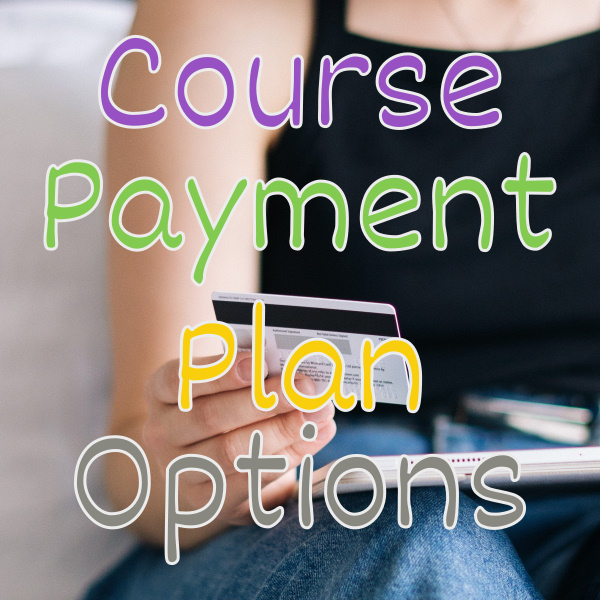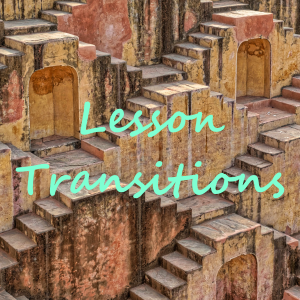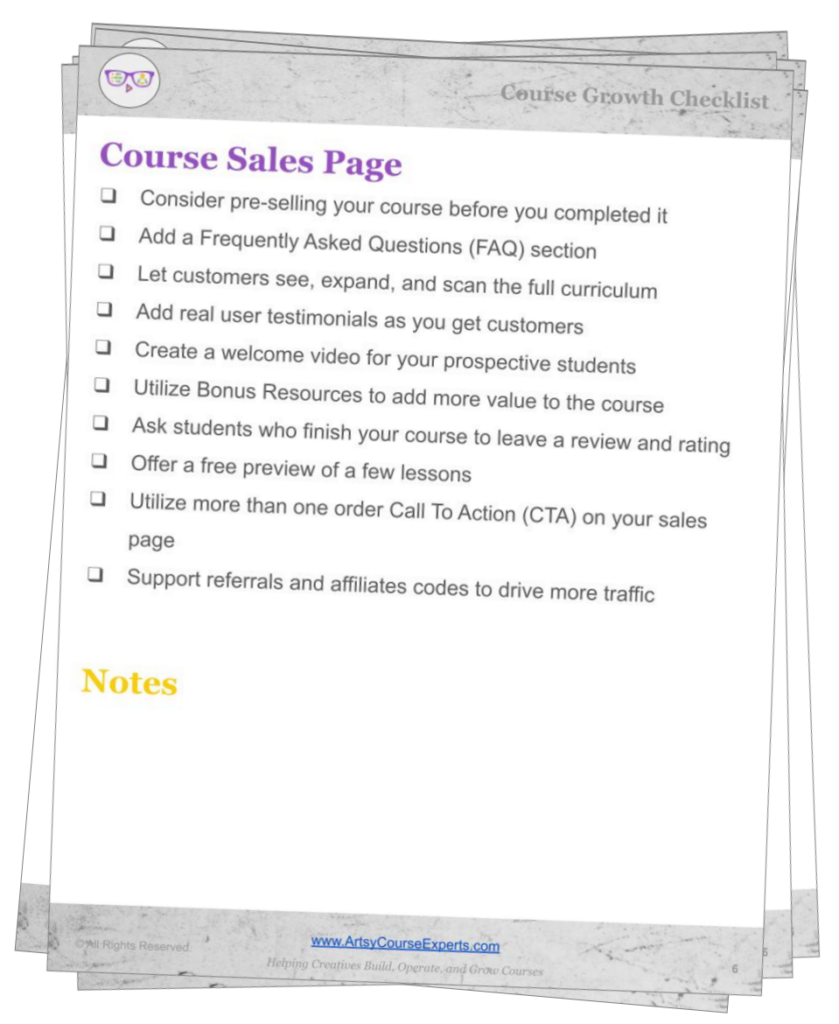Introduction
One way to make online courses more accessible and affordable for your students is to offer course payment plan options. Payment plans allow students to spread out the cost of the online course over a period of time if they can’t pay for the full amount upfront. This can be especially helpful for students who may not have the financial resources to pay the full amount before they learn the new higher-earning skills.
Payment plans may also be helpful to teachers if they haven’t finished the course yet and they are releasing them over time. In this lesson, we will explore what a payment plan option is, how it’s beneficial to you and your students, and the difference between payment plan options and one-time payments.
These are some of the potential problems that online course teachers could experience if they don’t offer payment plan options:
- By not offering payment plan options, you may be limiting the accessibility of your course to a certain group of people.
- If potential students are unable to afford the upfront cost of your course, they may opt to take a different course that offers payment plan options.
- Students who have to pay the full price upfront may feel overwhelmed with buyer’s remorse and may request a refund.
- Without payment plan options, course teachers may be unable to generate the extra revenue that comes with students paying by installment.
- Teachers may be forced to use a lower total price to acquire new students, instead of a higher price course with an installment plan option.
Video Lesson – How To Give Your Students A Much More Affordable Way To Pay For Your Courses Over Time
What Is a Course Payment Plan?
A course payment plan entails allowing students to pay for a course using smaller payments spread over several months.
It’s basically an installment plan where they don’t pay for the whole course upfront but gradually pay over a period of time.
Typically, a course payment plan involves the student making a down payment at the time of purchasing the course and then paying the remaining balance in installments over a period of time. The frequency and amount of the installments will vary depending on the terms of the payment plan.
Some payment plans charge a larger total amount compared to the price of the one-time payments. As a teacher, you can decide that. So a one-time payment could be $500, but multiple small payments could add up to $700.
You can also decide to change the amounts of money across different payments. For example, a student’s first payment could be $200 but with subsequent months at $100.
Subscriptions are similar to payment plans but usually, when a subscription ends, the access ends. With payment plans, once students pay in full, they usually still get access to the content for many more months or years or life.
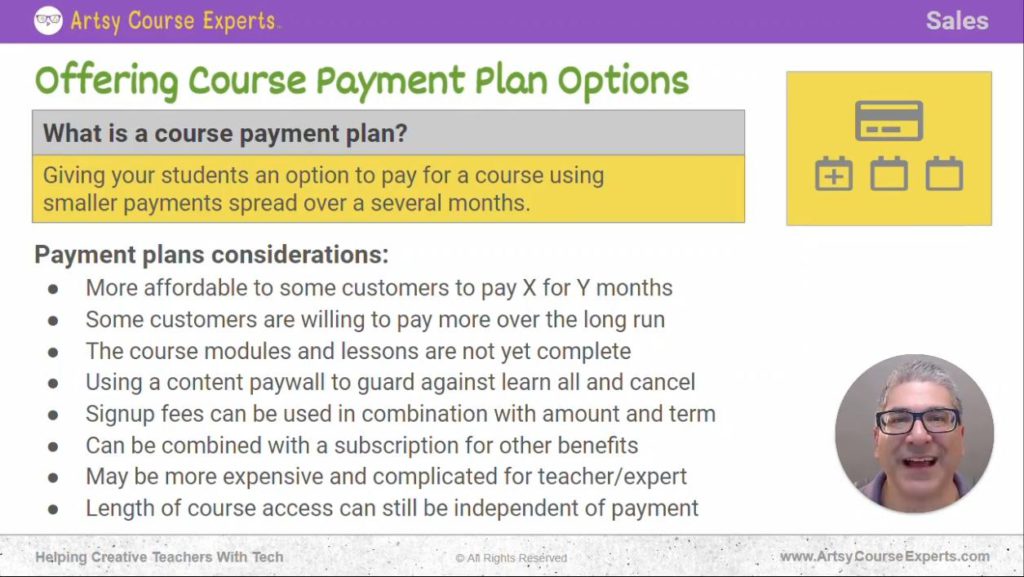
Payment Plans Considerations
More Affordable for Customers to Pay Over Several Months
Here’s something to think about, a payment plan could be significantly more affordable to some customers who pay X over Y months. This means paying a certain amount is spread out over six months, three months, et cetera.
There are different options that you can play with there, but instead of having that cash outlay from your students all in one shot, they can spread it out, making it significantly more affordable.
For example, A course on creating different acrylic nail designs may cost $100, but the students can pay $10 every month for 10 months.
You can also utilize several payment plans at once:
- Pay $100 for full course now – total is $100
- Pay $20 for 6 months – total is $120
- Pay $15 over 10 months – total is $150
Some Customers Are Willing to Pay More over the Long Run
Some customers or students are willing to pay more over time. This is similar to a subscription plan where you pay $15 a month, or get one of the best deals and save with the discounted annual rate.
Many people are okay with that because they may want to prioritize and manage their cash, have extra money, or just want to save the right amount.
Your students will be willing to pay more, even if it’s in the long run. Maybe the total amount for your course is a certain price, say $500, but your customers that pay little by little are willing to pay $600 or $700 as long as you spread it out.
The Course Modules and Lessons Are Not Yet Complete
For teachers, the course modules might not be available for purchase yet. Maybe you haven’t finished creating all your courses and lessons.
You can offer a payment plan and utilize a drip campaign to see content little by little. As a teacher, you can utilize a drip campaign via email or an LMS system like thinkific, but only allow students to access completed courses, and future courses can be in draft or coming soon mode.
It might be best to encourage students to use a payment plan or even a subscription variation where they receive courses once they start paying. This buys you time to complete the later modules that aren’t yet complete or polished.
Signup Fees Can Be Used in Combination with the Amount and Term
With a payment plan, you can also utilize a signup fee.
That way, the fee for the first month can require a larger first payment than for subsequent months.
You can mix and match that signup fee for that first month combined with how many x and y months.
If you do this, you can frame the extra amount as a larger first month or a finance fee because of the risk you are taking. It can even be thought of as upfront interest that the customer pays. Please check with your lawyers and accountants to figure out how to best frame the finance fee.
It Can Be Combined with a Subscription for Other Benefits
Another thing you can do is take a payment plan or even an additional, traditional full-course payment and combine that with a subscription for other benefits or bundles.
So if you are selling a course and they pay all at once or buy this bundle of services, they also get access to extra content. The content increases the real cost because students will see extra perceived value in the large bundle.
When you mix and match these combinations, you can use them to encourage students. So, for instance, if you pay for the more premium annual plan, you also get this extra perk, these extra data files, or this extra one-on-one coaching.
It May Be More Expensive and Complicated for the Teacher or Expert
Adding a payment plan can be tricky to add to your LMS platform or technology stack.
Here are some of the problems with adding payment plans:
- You may need a higher tier LMS like Thinkific Pro version
- You may need more advanced payment gateways like Stripe
- You may need more advanced plugins
- You’ll have to test many combinations and get ready to handle more billing failures and problems
- Auditing and billing can get more complicated
- Taxes can be trickier to track and accounting rules can be more complicated
- You may need a lawyer to help you with your billing terms & conditions
The whole system could get potentially more complicated, but a payment plan could open you up to many more students than you’re getting today.
So if you are going to explore the benefits of a payment plan, you also need to remember that it is a bit harder to configure your system for those options.
Length of the Course Can Still Be Independent of Payment
Keep in mind that the length of the course access is independent of the payment. The students either pay in full or use a payment plan to get access to your content.
But as a course teacher, you can decide if the students will have the course content once it is fully paid for years to come or until the final payment. If you don’t want to treat the payment plan like a subscription, then after the last payment, students can continue to access your course resources for as long as students that paid in full have access.
So you, as the teacher and business owner, you get to decide how long your students will have access to your content.
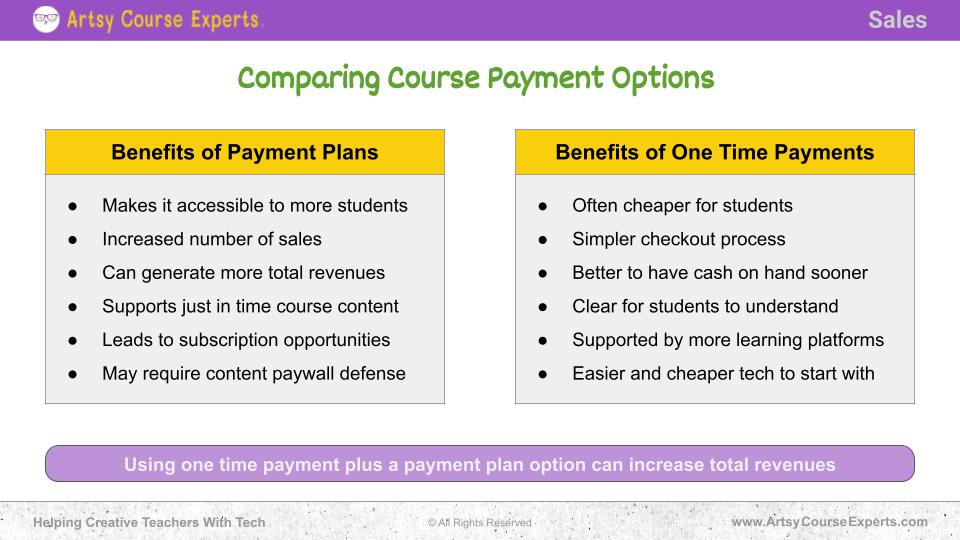
Comparing Course Payment Options
This supporting chart helps teachers analyze the benefits of payment plans versus one-time payments. Remember, as a teacher, you can offer:
- Full payment only
- Payment plans only
- Either full payment or payment plans
Frequently Asked Questions about Offering Course Payment Plan Options

Summary – On How To Offer Course Payment Plans
In summary, payment plans make courses accessible to more students, you’ll get more sales, and can even increase your total revenue.
Traditional one-time payments provide teachers with more money right away and with a simpler checkout process for students.
Finally, when you combine one-time payments with flexible payment plans, your total revenues will increase because you will sell to more students and earn a larger total income.
Here are some final tips for offering course payment plan options:
- Consider how many installment months you will spread the payment over
- Think about how much more the payment plan will be when compared to a discounted full payment
- Will all payments be the same amount or will the first payment be larger
- Ensure you clearly communicate the payment plan terms and conditions with your students
- Use Stripe or Paypal to automate payments and subscriptions and to reduce financial errors
- Stay organized and keep accurate records of payment plan agreements and payment totals
Hopefully, this course payment plan tutorial has made you smarter in planning for your online courses, community, and teacher website.
For more creative teacher help building, operating, and growing your online courses, check out our ArtsyCourseExperts blog and subscribe to our email for regular tips.
More Tips For Online Teachers
These lessons can also help you with course planning, administration, finance, and technology:
- Stripe Payment Fundamentals For Online Course Teachers
- Handling Student Buyer’s Remorse For Online Courses
- Diversity, Equity, and Inclusion (DEI) For Online Course Creators
- Learning about Monthly Recurring Revenue for Online Course Creators
- Teaching Creative Online Courses Using Drip Feeding
Related Services For Teachers and Experts
We offer these services to help your course business with setting up your payment technology:

